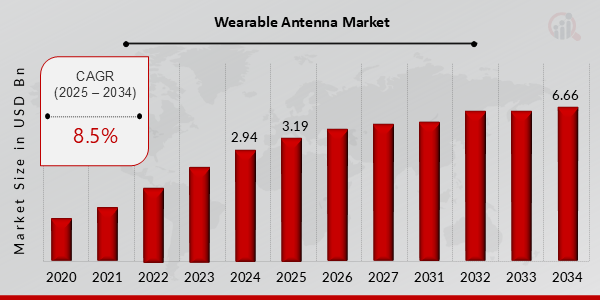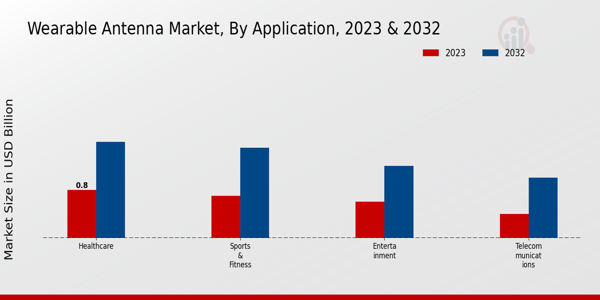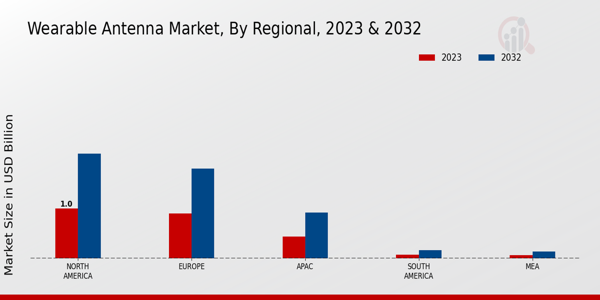Global Wearable Antenna Market Overview
Wearable Antenna Market Size was estimated at 2.94 (USD Billion) in 2024. The Wearable Antenna Market Industry is expected to grow from 3.19 (USD Billion) in 2025 to 6.66 (USD Billion) till 2034, exhibiting a compound annual growth rate (CAGR) of 8.5% during the forecast period (2025 - 2034)
Key Wearable Antenna Market Trends Highlighted
The Wearable Antenna Market is presently impacted by multitudes of market forces that influence it. An upsurge in demand for smart wearables like fitness bands and smartwatches has increased the requirement for compact efficient antennas. Also, the growth of IoT and improvement of communication technologies are providing the market with the necessity of better connectivity options. People are interested in devices which can fulfill functions but are also used in a much more integrated manner. These changes in the mean of utilization to more interconnected devices are compelling the producers to innovate and improve antenna designs for better outcomes.
Expansion of wearable technologies has been done by the growth of 5G, sub mm-wave frequencies, which have a major role to play as the 5G networks get rolled out. There is also a surge in the market using technology with an aim of health and wellbeing centres. As the marketing for medical wears becomes stronger people will invest in antennas that are manufactured for wearable media or sensors. AI in turn allows for new antenna concepts to be developed which are more suited for smart wearables. Recently, these trends have been directed towards the development of smaller and more flexible antennas that would permit the production of lighter and more effective devices.
People are moving towards antennas that are capable of working in different conditions and environments. Eco-friendly materials and technologies are already being used in a number of companies that will also outperform existing ones. As wearable technologies become a part of everyday life, demand increases for innovative functions and sophisticated products which will eliminate barriers for new products to hit the market. Incorporation of technology with personalisation will remain a key aspect of driving the future of this market.

Source: Primary Research, Secondary Research, MRFR Database and Analyst Review
Wearable Antenna Market Drivers
Rising Adoption of Smart Wearable Devices
The surge in demand for smart wearable devices has significantly propelled the Wearable Antenna Market Industry. As consumers become more health-conscious and tech-savvy, the integration of antennas in fitness trackers, smartwatches, and other wearable gadgets is becoming essential. These devices require efficient and reliable connectivity to provide real-time data on health metrics, location tracking, and communication. Consequently, manufacturers are continuously innovating, pushing the boundaries of antenna design to ensure seamless interfacing with networks and enhancing the functionality of wearable devices.The evolution of 5G technology also plays a crucial role in this trend, as it demands high-performance antennas that can support faster data transfer and improved connectivity. Moreover, as the Internet of Things (IoT) continues to expand, the need for wearable technology equipped with advanced antenna systems becomes even more critical. This overall drive towards smart wearables rich with features, coupled with increased consumer spending on technology, is propelling significant growth in the Wearable Antenna Market Industry.
Technological Advancements in Antenna Design
The continuous technological advancements in antenna designs represent a key driver for the Wearable Antenna Market Industry. Innovations such as miniaturization, flexibility, and integration with other electronic components enhance performance while maintaining the lightweight nature of wearable devices. By improving bandwidth and radiation efficiency, these advancements create better user experiences, thereby boosting the market demand for sophisticated wearable antennas.
Increased Focus on Health Monitoring
An increased focus on health monitoring due to rising health awareness and the growing incidences of chronic diseases is driving the Wearable Antenna Market Industry. Wearable devices equipped with antennas are increasingly being used in monitoring vital health statistics, paving the way for a proactive approach to personal healthcare management. This trend is supported by healthcare providers and insurers acknowledging the benefits of such technology, further stimulating demand.
Wearable Antenna Market Segment Insights
Wearable Antenna Market Application Insights
The Wearable Antenna Market revenue shows a considerable growth trajectory, with the Application segment playing a critical role in shaping its landscape. The market is primarily categorized into various applications, including Healthcare, Sports & Fitness, Entertainment, and Telecommunications, each holding a distinct value within the overall sector. In 2023, the Healthcare segment was valued at 0.8 USD Billion, highlighting its significant role in enabling advanced monitoring and diagnostics through wearable technology. As health awareness increases, this segment is projected to grow to 1.6 USD Billion by 2032, showcasing its importance in promoting better healthcare outcomes through technological innovations.The Sports Fitness sector, valued at 0.7 USD Billion in 2023, emphasizes the rising demand for wearables that track performance and health metrics.
This segment is expected to expand to 1.5 USD Billion by 2032, driven by the increasing participation in fitness activities and the demand for personalized fitness solutions. The integration of wearable antennas into sports devices helps athletes optimize their training and monitor their physical conditions more accurately.In the Entertainment sector, with a valuation of 0.6 USD Billion in 2023, wearable antenna technology is paving the way for immersive experiences in gaming and augmented reality applications. This application is anticipated to rise to 1.2 USD Billion by 2032, reflecting its role in transforming entertainment experiences and enhancing user engagement through wearables that connect users more seamlessly to their devices.The Telecommunications application, while currently valued at 0.4 USD Billion in 2023, is expected to grow to 1.0 USD Billion by 2032, showcasing its growing significance in ensuring constant connectivity and communication through wearable technologies.
The ability to maintain reliable connections supports various functionalities of smart wearables, thereby driving further innovation and adoption in telecommunications.Overall, the Wearable Antenna Market statistics highlight the dynamic nature of these applications, with Healthcare and Sports Fitness leading the charge due to their direct impact on personal health and fitness improvement. The market growth within these areas is further complemented by increasing consumer demand for innovative and effective solutions in both personal and professional settings, driving the proliferation of wearable antennas across multiple sectors. As the applications continue to evolve, they present considerable opportunities for advancements in technology, making them essential components of the Wearable Antenna Market industry.

Source: Primary Research, Secondary Research, MRFR Database and Analyst Review
Wearable Antenna Market Frequency Band Insights
The Wearable Antenna Market, particularly in the Frequency Band segment, is poised for considerable growth, with a valuation of 2.49 billion USD in 2023 and projected to reach 5.2 billion USD by 2032. The segmentation within this market includes ranges such as Sub 1 GHz, 1 GHz to 5 GHz, 5 GHz to 10 GHz, and Above 10 GHz. The 1 GHz to 5 GHz range is particularly significant as it supports a majority of wireless communications used in wearable devices, driving substantial demand. Meanwhile, the Sub 1 GHz range offers advantages in long-range communication and power efficiency, making it essential for various applications.The Above 10 GHz range is increasingly becoming critical due to the rise of advanced applications like augmented reality and high-definition streaming. Overall, the performance, efficiency, and growing popularity of these frequency bands play a crucial role in shaping the landscape of the wearable antenna market. As advancements in technology continue, the Wearable Antenna Market data indicates significant opportunities, although challenges such as regulatory standards and device compatibility remain pertinent. With trends leaning towards IoT integration and smart wearable technology, the market growth is likely to accelerate, making the Frequency Band segment a focal point for stakeholders and innovators in the industry.
Wearable Antenna Market Material Type Insights
The Wearable Antenna Market, with a projected revenue of 2.49 billion USD in 2023, showcases significant growth opportunities across various material types, including Metal, Plastic, Ceramic, and Fabric. Metal antennas continue to dominate this segment due to their excellent conductivity and performance in wireless communication, making them indispensable for high-frequency applications. Plastic antennas are gaining traction due to their lightweight and flexible properties, enabling innovative designs and broader adoption in consumer electronics.Ceramic materials contribute by offering durable and stable performance, particularly in specialized applications where robustness is crucial. Meanwhile, Fabric antennas are becoming increasingly popular in wearable technology due to their comfort and adaptability, thus catering to the growing trend for smart textiles. As the market evolves, these material types play critical roles in driving technological advancements, impacting the overall Wearable Antenna Market statistics, and responding to the rising demand for versatile, efficient, and durable antennas in various industries.The diverse fabrications also highlight the dynamic nature of the Wearable Antenna Market segmentation, revealing opportunities for innovation and competition within the industry.
Wearable Antenna Market Connectivity Technology Insights
The Wearable Antenna Market, particularly focusing on the Connectivity Technology segment, showcased a robust market valued at 2.49 USD Billion in 2023. This market is projected to experience significant growth, with increasing adoption of wearable technology driving its expansion. Connectivity solutions like Bluetooth and Wi-Fi continue to dominate this market due to their widespread applications in personal devices, enabling seamless communication and data transfer. NFC technology, while holding a smaller share, is gaining traction, especially in contactless payment solutions, which add further value to wearable devices.Zigbee is also increasingly important as it facilitates low-power connectivity for IoT-enabled wearables, paving the way for enhancing interactions among devices. The overall dynamics of the Wearable Antenna Market revenue are influenced by trends such as increased consumer awareness, technological advancements, and an expanding ecosystem of smart devices. However, challenges such as limited battery life and spectrum regulations persist, creating both hurdles and opportunities for growth in the Wearable Antenna Market industry, ultimately contributing to noteworthy market growth through 2032.
Wearable Antenna Market Regional Insights
The Wearable Antenna Market is anticipated to showcase significant growth across various regions, with North America leading the segment. In 2023, the North America market was valued at 1.0 USD Billion, expected to reach 2.1 USD Billion in 2032, making it a majority holding in the overall market revenue. Europe follows closely, valued at 0.9 USD Billion in 2023, with projections of 1.8 USD Billion by 2032, indicating a significant presence in wearable technology. The APAC region has also demonstrated potential, valued at 0.44 USD Billion in 2023, and is expected to grow to 0.92 USD Billion by 2032.While South America and MEA recorded valuations of 0.08 USD Billion and 0.07 USD Billion, respectively, in 2023, with anticipated growth to 0.17 USD Billion and 0.14 USD Billion by 2032, these regions remain smaller players in comparison. The dominant positions of North America and Europe in the Wearable Antenna Market can be attributed to advancements in technology and increasing adoption of IoT devices. The overall market growth is driven by rising demand for connected devices and innovative applications in health and wellness. However, challenges such as high manufacturing costs and technological constraints could hinder the expansion in certain regions, presenting both obstacles and opportunities for the Wearable Antenna Market industry.

Source: Primary Research, Secondary Research, MRFR Database and Analyst Review
Wearable Antenna Market Key Players and Competitive Insights
The Wearable Antenna Market is characterized by the rapid proliferation of advanced technologies catering to the evolving needs of consumers for connectivity and performance in wearable devices. As the demand for multifunctional and compact wearables continues to surge, various players in this field are innovating and refining their antenna technologies to enhance communication capabilities in devices such as smartwatches, fitness trackers, and augmented reality headsets. This competitive landscape is marked by significant investments in research and development, with a focus on miniaturization, integration, and improved signal performance to serve an increasingly connected world. Key trends include the integration of 5G capabilities and the proliferation of IoT devices, which are driving stakeholders to enhance their offerings continually and expand their market reach.Qualcomm stands out in the Wearable Antenna Market due to its robust technological capabilities and strong market presence.
The company has leveraged its expertise in semiconductor solutions to develop advanced antenna systems tailored for a broad range of wearable applications. Qualcomm's strategic partnerships with established device manufacturers have enabled it to create integrated solutions that enhance the performance and reliability of wearable devices. The company's commitment to innovation is reflected in its continuous efforts to optimize antenna designs for size, efficiency, and performance, resulting in superior connectivity and user experience. Qualcomm's strong branding and reputation as a pioneer in wireless technology further bolster its competitive edge, making it a dominant player in this niche.Panasonic also plays a significant role in the Wearable Antenna Market, leveraging its extensive experience in electronics and telecommunications to provide high-quality antenna solutions. One of Panasonic's strengths lies in its ability to deliver innovative products that combine functionality with durability, catering to the demands of various wearable applications.
The company focuses on sustainability and energy-efficient designs, which resonate well with the environmentally conscious consumer segment. Panasonic’s dedication to research and development enables it to stay at the forefront of technological advancements, offering versatile antenna solutions that are integrated into many wearable devices. The company's comprehensive suite of products and unwavering commitment to quality serve to reinforce its standing in the competitive landscape, contributing to the overall growth of the wearable antenna sector.
Key Companies in the Wearable Antenna Market Include
- Qualcomm
- Panasonic
- Fitbit
- Amphenol
- Samsung Electronics
- Garmin
- Tektronix
- Laird Connectivity
- Nokia
- Huawei
- Bosch
- Apple
- Medtronic
- Sony
- Zebra Technologies
Wearable Antenna Industry Developments
The Wearable Antenna Market has recently witnessed notable developments, particularly regarding advancements in technology and partnerships among key players. Qualcomm and Samsung Electronics are enhancing their collaboration to advance 5G wearable technology, which is anticipated to increase demand for sophisticated antenna systems. Meanwhile, Panasonic has expanded its research into flexible antenna designs aimed at maximizing wearability and comfort while maintaining performance. The market is also seeing significant growth due to increased consumer demand for fitness and health monitoring devices, with companies like Fitbit and Garmin releasing new products featuring enhanced antenna capabilities. On the merger and acquisition front, no recent publicly disclosed mergers involving major companies like Apple, Huawei, or Sony have been reported, indicating a phase of organic growth rather than consolidation. The valuation of companies within this sector continues to rise, driven by ongoing innovations and heightened competition, which is likely to further propel advancements in wearable antenna technology. As the demand for connected devices increases, the importance of effective antennas in optimizing communication will continue to shape the strategies of these leading companies.
Wearable Antenna Market Segmentation Insights
Wearable Antenna Market Application Outlook
- Healthcare
- Sports Fitness
- Entertainment
- Telecommunications
Wearable Antenna Market Frequency Band Outlook
- Sub 1 GHz
- 1 GHz to 5 GHz
- 5 GHz to 10 GHz
- Above 10 GHz
Wearable Antenna Market Material Type Outlook
- Metal
- Plastic
- Ceramic
- Fabric
Wearable Antenna Market Connectivity Technology Outlook
- Bluetooth
- Wi-Fi
- NFC
- Zigbee
Wearable Antenna Market Regional Outlook
- North America
- Europe
- South America
- Asia Pacific
- Middle East and Africa
|
Report Attribute/Metric
|
Details
|
|
Market Size 2024
|
USD 2.94 Billion
|
|
Market Size 2025
|
USD 3.19 Billion
|
|
Market Size 2034
|
USD 6.66 Billion
|
|
Compound Annual Growth Rate (CAGR)
|
8.5% (2025-2034)
|
|
Base Year
|
2024
|
|
Market Forecast Period
|
2025-2034
|
|
Historical Data
|
2020-2023
|
| Market Forecast Units |
USD Billion |
| Key Companies Profiled |
Qualcomm, Panasonic, Fitbit, Amphenol, Samsung Electronics, Garmin, Tektronix, Laird Connectivity, Nokia, Huawei, Bosch, Apple, Medtronic, Sony, Zebra Technologies |
| Segments Covered |
Application, Frequency Band, Material Type, Connectivity Technology, Regional |
| Key Market Opportunities |
Rising demand for IoT devices, Integration in healthcare applications, Growth in the smart clothing market, Advances in 5G technology, Increased consumer interest in wearables |
| Key Market Dynamics |
Growing adoption of IoT devices, Increasing demand for fitness tracking, Advancements in antenna technology, Miniaturization of wearable devices, Expanding 5G connectivity requirements |
| Countries Covered |
North America, Europe, APAC, South America, MEA |
Frequently Asked Questions (FAQ) :
The Wearable Antenna Market is expected to be valued at 6.66 USD Billion in 2034.
The market is expected to grow at a CAGR of 8.5% from 2025 to 2034.
North America holds the largest market share, valued at 1.0 USD Billion in 2023.
The market size in Europe is valued at 0.9 USD Billion for the year 2023.
The Healthcare application segment is expected to reach 1.6 USD Billion by 2032.
Major players include Qualcomm, Panasonic, Fitbit, Amphenol, Samsung Electronics, and Garmin.
The Sports Fitness application segment is valued at 0.7 USD Billion in 2023.
The telecommunications application segment is expected to grow from 0.4 USD Billion in 2023 to 1.0 USD Billion in 2032.
The market in the APAC region is expected to reach 0.92 USD Billion in 2032.
The Entertainment application segment is projected to be valued at 1.2 USD Billion by 2032.

















